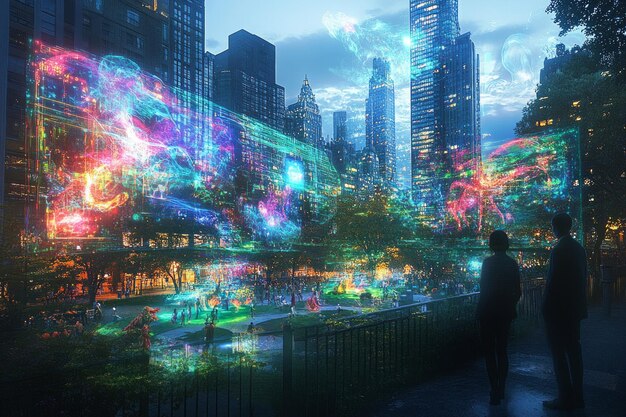The Future of Entertainment: Streaming and Interactive Media in the US

The future of entertainment in the US is being reshaped by the convergence of streaming services and interactive media, offering personalized and immersive experiences that redefine how audiences consume content.
The entertainment landscape in the US is rapidly evolving, driven by advancements in technology and changing consumer preferences. The convergence of the future of entertainment: how streaming and interactive media are evolving in the US, is creating unprecedented opportunities and challenges for both creators and consumers.
The Rise of Streaming Dominance
Streaming services have become a ubiquitous part of the American entertainment diet. From on-demand movies and TV shows to live sports and news, streaming platforms offer a vast array of content accessible anytime, anywhere. This accessibility has fundamentally altered how people consume media, shifting away from traditional broadcast models.
Subscription Video on Demand (SVOD)
SVOD services like Netflix, Hulu, and Disney+ have led the charge in the streaming revolution. Their vast libraries of content, original programming, and user-friendly interfaces have attracted millions of subscribers in the US. These platforms continue to invest heavily in content creation to retain subscribers and attract new ones.
The Impact on Traditional Media
The rise of streaming has had a profound impact on traditional media companies. Many have launched their own streaming services to compete in the digital landscape. This has led to a fragmentation of content, with consumers needing multiple subscriptions to access all the shows and movies they want.

- Cord-Cutting: More Americans are “cutting the cord” and ditching traditional cable subscriptions in favor of streaming services.
- Original Content: Streaming platforms are heavily investing in original content to differentiate themselves and attract subscribers.
- Personalized Recommendations: Streaming services use algorithms to provide personalized recommendations, enhancing the viewing experience.
- Global Reach: Streaming platforms are expanding their reach globally, bringing US content to international audiences.
In conclusion, streaming dominance in the US entertainment market is undeniable. SVOD services have transformed content consumption and challenged traditional media, leading to an increasingly fragmented and competitive landscape.
Interactive Media: Beyond Passive Viewing
Interactive media is transforming passively watching entertainment into actively engaging with it. From video games and virtual reality to interactive storytelling and live streaming, these formats offer immersive and personalized experiences that captivate audiences in unprecedented ways. This shift towards interactivity is reshaping the future of entertainment.
Video Games: The Ultimate Interactive Experience
Video games have long been the king of interactive entertainment. With advancements in graphics, gameplay, and online connectivity, video games offer immersive experiences that rival traditional forms of entertainment. The eSports industry, in particular, has exploded in popularity, attracting millions of viewers and participants.
Virtual and Augmented Reality (VR/AR)
VR and AR technologies are poised to revolutionize the entertainment industry. VR offers fully immersive experiences, transporting users to virtual worlds where they can interact with environments and characters. AR overlays digital information onto the real world, enhancing real-life experiences with interactive elements.

- Interactive Storytelling: Viewers can influence the plot and outcome of a story through choices and decisions.
- Live Streaming: Platforms like Twitch and YouTube allow creators to interact with their audience in real-time.
- Gamification: Incorporating game-like elements into non-game contexts to increase engagement and motivation.
- Personalized Experiences: Tailoring content and experiences to individual user preferences.
In conclusion, interactive media is revolutionizing the entertainment industry by offering viewers opportunities to actively participate and engage with content. Video games, VR/AR, and interactive storytelling are leading the charge, providing immersive and personalized experiences that redefine entertainment.
Personalization and Customization Trends
Personalization and customization are becoming increasingly important in the entertainment industry. Consumers expect content and experiences tailored to their individual preferences and needs. Streaming services and interactive media platforms are leveraging data and algorithms to deliver personalized recommendations and customized experiences.
Data-Driven Recommendations
Streaming services use sophisticated algorithms to analyze user viewing habits and preferences. This data is used to recommend movies, TV shows, and other content that viewers are likely to enjoy. Personalized recommendations increase user engagement and satisfaction, leading to higher retention rates.
Customizable Content
Interactive media platforms allow users to customize their experiences in various ways. Video games offer character customization options, allowing players to create unique avatars. Interactive storytelling allows viewers to influence the plot and outcome of a story.
The rise of personalization and customization is driven by the increasing availability of data and advancements in artificial intelligence. These technologies allow entertainment companies to understand user preferences and deliver tailored experiences at scale.
In conclusion, personalization and customization are transforming the entertainment industry, enabling companies to deliver tailored content and experiences that increase user engagement and satisfaction. Data-driven recommendations and customizable content are becoming standard features on streaming services and interactive media platforms.
The Convergence of Streaming and Interactive Media
The convergence of streaming and interactive media is creating new and exciting possibilities for entertainment. Streaming services are incorporating interactive elements into their platforms, while interactive media platforms are leveraging streaming technology to deliver immersive experiences. This convergence is blurring the lines between passive viewing and active engagement.
Interactive Streaming
Streaming services are experimenting with interactive formats that allow viewers to participate in the storytelling process. Netflix released “Black Mirror: Bandersnatch,” an interactive movie where viewers make choices that affect the plot. This experiment demonstrated the potential of interactive streaming and paved the way for future innovations.
Live Streaming and Gaming
Live streaming platforms like Twitch and YouTube have become hubs for interactive entertainment. Gamers stream their gameplay live, interacting with viewers in real-time. These platforms also host live concerts, talk shows, and other interactive events.
- Enhanced Engagement: Interactive elements increase viewer engagement and create more immersive experiences.
- New Revenue Streams: Interactive formats open up new revenue streams through in-app purchases, subscriptions, and sponsorships.
- Community Building: Interactive experiences foster a sense of community among viewers and creators.
In conclusion, the convergence of streaming and interactive media is creating new forms of entertainment that are more engaging, personalized, and community-driven. Interactive streaming, live streaming, and gaming are at the forefront of this trend, blurring the lines between passive viewing and active participation.
Challenges and Opportunities in the Evolving Landscape
The evolving entertainment landscape presents both challenges and opportunities for creators, distributors, and consumers. Navigating this landscape requires a deep understanding of the trends, technologies, and consumer preferences that are shaping the future of entertainment in the US.
Content Overload and Fragmentation
The abundance of content available on streaming services can be overwhelming for consumers. With so many choices, it can be difficult to find the shows and movies they want to watch. The fragmentation of content across multiple platforms also requires consumers to subscribe to multiple services, increasing costs and complexity. This can lead to “subscription fatigue,” where consumers become overwhelmed and cancel subscriptions.
Monetization Strategies
Entertainment companies face the challenge of monetizing their content in the digital age. Traditional revenue models based on advertising and subscription fees are being disrupted by new models such as in-app purchases, microtransactions, and sponsorships. Finding the right monetization strategy is crucial for long-term success.
Despite these challenges, the evolving entertainment landscape also presents numerous opportunities. Content creators can reach wider audiences than ever before through streaming platforms and interactive media. New technologies such as VR/AR and AI are opening up new avenues for creativity and innovation.
In conclusion, the future of entertainment in the US is full of both challenges and opportunities. By understanding the trends and technologies that are shaping the landscape, creators, distributors, and consumers can navigate this evolving world and create engaging, personalized, and profitable entertainment experiences.
The Future of Entertainment: Predictions and Trends
Predicting the future of entertainment is a complex endeavor, but several key trends and technologies are likely to shape the industry in the coming years. From artificial intelligence and blockchain to the metaverse and Web3, these innovations have the potential to revolutionize how content is created, distributed, and consumed.
Artificial Intelligence and Content Creation
AI is already playing a significant role in the entertainment industry, from generating personalized recommendations to creating realistic visual effects. In the future, AI is likely to become even more involved in content creation, assisting with tasks such as scriptwriting, music composition, and animation. AI-powered tools can help creators accelerate their workflows and produce high-quality content more efficiently.
Blockchain and NFTs
Blockchain technology and non-fungible tokens (NFTs) are emerging as new ways to monetize and distribute entertainment content. NFTs can be used to represent ownership of digital assets such as artwork, music, and video clips. Creators can sell NFTs directly to fans, bypassing traditional intermediaries and retaining a greater share of the revenue. Blockchain can also be used to create decentralized entertainment platforms that are more transparent and equitable.
- The Metaverse: A persistent, shared virtual world where users can interact with each other and digital content.
- Web3: A decentralized internet built on blockchain technology, empowering users with greater control over their data and digital assets.
- 5G and Edge Computing: Faster internet speeds and lower latency will enable more immersive and interactive entertainment experiences.
In conclusion, the future of entertainment in the US is likely to be shaped by a combination of technological advancements and shifts in consumer behavior. Artificial intelligence, blockchain, the metaverse, and Web3 are poised to revolutionize the industry, creating new opportunities for creators, distributors, and consumers alike.
| Key Point | Brief Description |
|---|---|
| 🎬 Streaming Dominance | Streaming services redefine content consumption in the US. |
| 🎮 Interactive Media | Video games, VR/AR transform passive viewing into active participation. |
| ✨ Personalization | Content is tailored to individual preferences using data-driven recommendations. |
| 🤖 AI & Blockchain | AI assists in content creation; blockchain enables new monetization models. |
FAQ
▼
Streaming offers on-demand access, personalized recommendations, and original content, shifting viewers from traditional TV to digital platforms like Netflix and Disney+.
▼
Interactive media like video games, VR, and live streaming allows viewers to engage actively, influencing stories and connecting in real-time, enhancing entertainment.
▼
Personalization tailors content using data to match individual preferences, heightening viewer satisfaction and engagement with recommendations and customizable options.
▼
Content overload, fragmentation across platforms, and finding sustainable monetization models are the main challenges for entertainment companies in the evolving US landscape.
▼
AI enhances content creation, while blockchain offers new monetization methods like NFTs, which provides creators more control by disintermediating how content is accessed.
Conclusion
In conclusion, the future of entertainment: how streaming and interactive media are evolving in the US, points towards an increasingly immersive, personalized, and decentralized landscape. Overcoming the challenges of content overload and embracing new technologies like AI and blockchain will be crucial for success in this rapidly evolving industry.





